Chardonnay
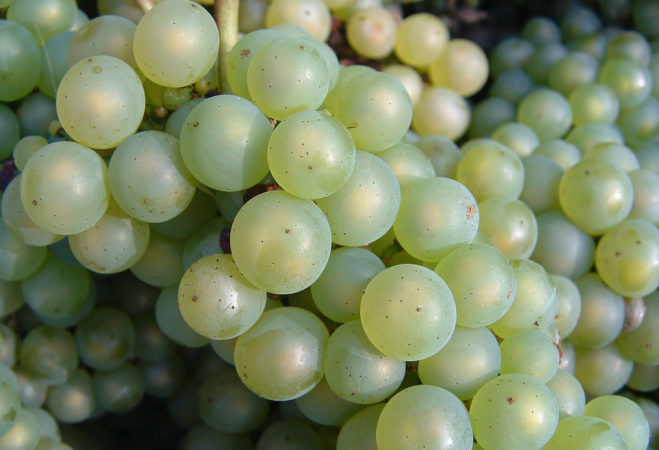
Chardonnay es la variedad blanca más apreciada, popular y extendida en el mundo y la número 2 después de la Cabernet Sauvignon. Originario de Borgoña (Francia), se ha adaptado con buenos resultados en lugares muy diferentes. ..........(Leer mas) El Chardonnay es la cepa preferida para la elaboración de vinos blancos secos, sus características pueden variar desde vinos ricos, gruesos y espesos, adecuados para envejecer en botella, a vinos más ligeros y frescos hechos sin madera y destinados a ser bebidos jóvenes. Es el cepaje clave de los afamados Chablis y es una de las variedades con que se elaboran el Champagne. Los vinos de Chardonnay, pueden llegar a ser extremadamente complejos expresando el carácter del terruño del cual proceden. Vista: El Chardonnay a la vista presenta un color variable entre paja muy pálido y amarillo paja más pronunciado, casi dorado, que en muchos casos se debe al aporte de la madera, y reflejos verdosos, los cuales están definidos por la variedad utilizada. Olfato: Los aromas característicos del Chardonnay poco maduro recuerdan a la manzana verde, los más maduros de clima frío alcanzan una notable acidez y huelen a limón, pomelo, pera, acacia, los de clima cálido adquieren aromas a frutas tropicales (mango, piña, banana, melón, ananá) puede aparecer algo de especias o caramelo. Con crianza en roble pueden aparecer aromas a vainilla, miel y manteca. Sabores: El Chardonnay es largo de boca, no tiene extremos duros ni una acidez agresiva. Presenta una gran gama de sabores los cuales están definidos por manzanas, cítricos, melón, peras, miel, cera, caramelo, dulce de leche, minerales entre los más reconocidos. Maduración El Chardonnay pueden ser consumido joven, sin madera, y los que han pasado por roble mejoran en botella entre tres y cinco años. Tiene una excelente capacidad de guarda; en estos casos, aparecen rasgos avainillados y tostados, color de almendra y aroma de avellanas y pan tostado. Maridajes: El Chardonnay es ideal para acompañar: Pescados blancos; La temperatura de servicio de un Chardonnay, la cual le permite al vino exponerse delante de nosotros destacando sus aromas y sabores, ronda entre 8° a 10º y los de crianza a 12°.
Pescados grillados y ahumados;
Mariscos;
Carnes blancas;
Platos vegetarianos;
Pastas;
Pollo asado;
Aves con salsas a la crema y poco condimento;
Comida picante.
The Chardonnay it is the most appreciated, popular and widespread white variety in the world and number 2 after the Cabernet Sauvignon. Originally from Burgundy (France) it has adapted with good results in very different places ..........(Reed more)
Chardonnay is the preferred strain for the production of dry white wines, the characteristics can vary from rich, thick and thick wines, suitable for aging in the bottle, to lighter and fresher wines made without wood and intended to be drunk young. It is the key strain of the famous Chablis and is one of the varieties with which Champagne is made.
Chardonnay wines, can become extremely complex expressing the character of the terroir from which they come.
Sight: The Chardonnay in sight has a variable color between very pale straw and yellow straw more pronounced, almost golden, which in many cases is due to the contribution of wood, and greenish reflections, which are defined by the variety used.
Smell: The characteristic aromas of the immature Chardonnay are reminiscent of the green apple, the most mature of cold weather reach a remarkable acidity and smell like lemon, grapefruit, pear, acacia, those of warm climate acquire aromas of tropical fruits (mango, pineapple, banana, melon, pineapple) some spices or caramel may appear. With oak aging, vanilla, honey and butter aromas may appear.
Flavors: Chardonnay is long on the palate, it has no hard ends or aggressive acidity. It presents a wide range of flavors which are defined by apples, citrus fruits, melons, pears, honey, wax, caramel, dulce de leche, minerals among the most recognized.
Maturation
The Chardonnay can be consumed young, without wood, and those who have gone through oak improve in the bottle between three and five years. It has an excellent storage capacity; In these cases, vanilla and toasted features, almond color and hazelnut aroma and toasted bread appear.
Pairing:
The Chardonnay is ideal to accompany:
White fish;
Grilled and smoked fish;
Seafood;
White meat;
Vegetarian dishes;
Pasta;
Roast chicken;
Birds with cream sauces and little seasoning;
Spicy food.
The service temperature of a Chardonnay, which allows the wine to be exposed in front of us, highlighting its aromas and flavors, ranges between 8 ° to 10 ° and those of aging at 12 °.
Sauvignon Blanc
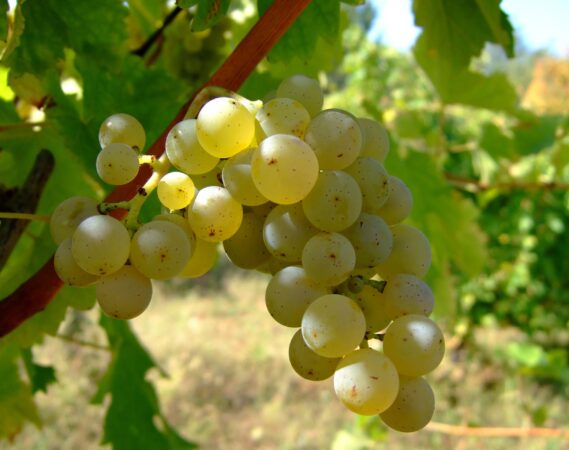
El nombre, Sauvignon Blanc, parece venir de la contracción de sauvage (salvaje) y vignon (viña). LaSauvignon Blanc es originaria de Burdeos, Francia, produce vinos de buen cuerpo, muy aromáticos y de buena acidez ..........(Lee Mas)
Su versatilidad es amplia, casi para todos los gustos y los tiempos: produce vinos refrescantes, secos, agresivos o simplemente listos
para beber. ElSauvignon Blanc es una variedad que se usa sola y en algunos casos la misma se combinada con la variedadSemillón obteniendo vinos finos blancos de excelente calidad. Luego de la Chardonnay, la Sauvignon Blanc es la variedad más fina en lo que a vinos blancos se refiere. En el mundo del vino, son reconocidos los Sauvignon Blanc de Sudáfrica y Chile.
Vista: A la vista el vino Sauvignon Blanc presenta un color amarillo verdoso, llegando a presentarse levemente verdoso con reflejos dorados.
Olfato: Los aromas primarios que emanan del Sauvignon Blanc son herbáceos, recuerdan a pasto recién cortado, la miel, el bizcocho, ananá, mango, pólvora, espárragos, pomelo rosado, miel, etc.
Sabores: A la boca el Sauvignon Blanc presenta un cantidad de ácidos notables, de gran personalidad y con sabores a pasto, pomelos rosados y en ciertos casos a yesca-pedernal. A veces, tiene acentos ahumados y un sabor ligeramente picante, que resalta su potencia aromática en el paladar.
Maduración
El Sauvignon Blanc es un vino para beber preferentemente joven, no está pensado para envejecer. Algunas bodegas se animan a hacerlo convivir un tiempo con la madera de roble logrando ejemplares excepcionales, que igualmente conservan su identidad. La fermentación en barrica produce una gama de sabores de frutas tropicales, a piña, banana, guayaba.
Maridajes:
El Sauvignon Blanc es ideal para acompañar:
Mariscos;
Pescados;
Comida picante;
Pastas con frutos de mar;
Aves;
Queso de cabra;
Son excelentes como aperitivos.
La temperatura de servicio de un Sauvignon Blanc, la cual le permite al vino exponerse delante de nosotros destacando sus aromas y sabores, ronda entre 8° y 10°.
The name, Sauvignon Blanc, seems to come from the contraction of sauvage (wild) and vignon (vineyard). Sauvignon Blanc is originally from Bordeaux, France, produces wines of good body, very aromatic and of good acidity .......... (Read More)
Its versatility is wide, almost for all tastes and times: it produces refreshing, dry, aggressive or simply wines ready to drink.
El Savignon Blanc is a variety that is used alone and in some cases it is combined with the Seed variety obtaining fine white wines of excellent quality. After Chardonnay, Sauvignon Blanc is the finest variety in terms of white wines. In the world of wine, Sauvignon Blanc from South Africa and Chile are recognized.
View: In view, Sauvignon Blanc wine has a greenish yellow color, becoming slightly greenish with golden highlights.
Smell: The primary aromas emanating from Sauvignon Blanc are herbaceous, reminiscent of freshly cut grass, honey, sponge cake, pineapple, mango, gunpowder, asparagus, pink grapefruit, honey, etc.
Flavors: In the mouth the Sauvignon Blanc presents a number of notable acids, of great personality and with flavors of grass, pink grapefruits and in certain cases to tinder-flint. Sometimes, it has smoky accents and a slightly spicy flavor, which highlights its aromatic potency on the palate.
Maturation
Sauvignon Blanc is a wine to drink preferably young, it is not intended to age. Some wineries are encouraged to make it live a time with oak wood achieving exceptional specimens, which also retain their identity. Fermentation in the barrel produces a range of tropical fruit flavors, pineapple, banana, guava.
Pairing:
The Sauvignon Blanc is ideal to accompany:
Seafood;
Fish;
Spicy food;
Pasta with seafood;
Birds;
Goat cheese;
They are excellent as snacks.
The service temperature of a Sauvignon Blanc, which allows the wine to be exposed in front of us highlighting its aromas and flavors, ranges between 8 ° and 10 °.
Pinot Noir
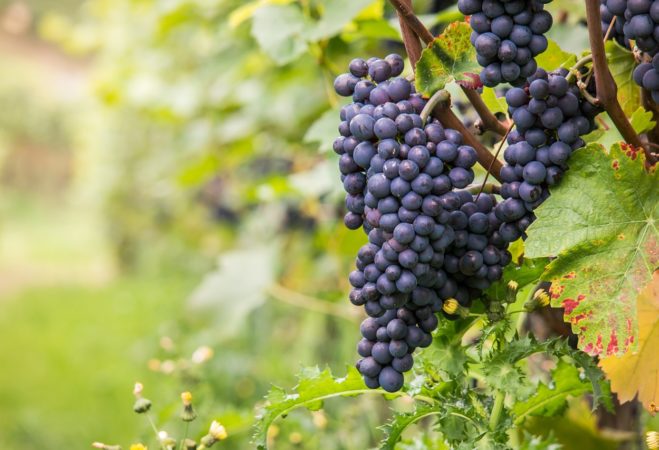
La Pinot Noir es la cepa tinta por excelencia de los vinos de La Bourgogne; su jugo es incoloro pero en contacto con la piel negra azulada brinda vinos notables por su color rojo intenso. La Pinot Noir produce vinos de mediana intensidad, de mediana concentración tánica. De color poco intenso, con aromas frutales y florales. ..........(Lee Mas)
De impactante paso por la boca, se ofrece elegante, con sabores muy agradables y de cuerpo envolvente. Los vitivinicultores consideran que la Pinot Noir es una uva complicada, no fácil de vinificar, puede vinificarse en blanco u obtener buenos vinos rosados en lo que se llama fermentación de una o dos noches. Vinificado en blanco es junto con el Chardonnay y el
Pinot Meunier, una de las tres uvas permitidas para la elaboración del Champagne, confiriéndole cuerpo y estructura, para lo cual debe vinificarse como vino blanco.
Vista: El Pinot Noir a la vista cuando es joven, es de color rojo rubí con reflejos violeta. A medida que envejece ofrece reflejos anaranjados y ocres, en aquellos vinos en los cuales el tiempo ha tenido un papel importante.
Olfato: Los aromas que presenta el Pinot Noir son a frutas rojas y negras como cereza, frambuesa, grosella, guinda, violeta, coco, pasto recién cortado. Cuando joven el Pinot Noir exhibe una amplia gama de aromas frutados de la franja de las frutillas, las frambuesas y grosellas.
Sabores: El Pinot Noir en boca es delicado, sus taninos y la acidez son bajos y aparecen sabores a frutillas, arándanos, violetas, canela, rosas y anís. Una característica muy común en los pinots argentinos es que huele a tierra u hongos. La crianza en roble le aporta marcadas expresiones de vainilla, tabaco y cuero.
Maduración
Es una variedad con un tanino y una acidez relativamente bajos, un color medio más que profundo y una vida media de duración más larga. Permiten un buen envejecimiento
Maridajes:
El Pinot Noir es ideal para acompañar:
Pescado;
Aves de caza (pato);
Comidas con salsas a base de hongos;
Platos de carne elaborados;
Pastas con crema(sin tomate).
Es conveniente abrir la botella dos o tres horas antes de consumirlo para oxigenarlo favoreciendo la persistencia de aromas y sabores.
Pinot Noir is the ink strain by excellence of La Bourgogne wines; its juice is colorless but in contact with bluish black skin providing notable wines for his intense red color. The Pinot Noir produces wines of medium intensity, of medium tannic concentration. Of little intense color, with fruity and floral aromas. ..........(Reed more)
Impressive passing through the mouth, it is offered elegant, with very pleasant flavors and enveloping body. The wine growers consider Pinot Noir a complicated grape, it is not easy to vinify, it can be vinified in white or obtain good rosé wines in what is called fermentation of one or two nights. White vinified is along with the Chardonnay and the Pinot Meunier, one of the three grapes allowed to make champagne, confirm body and structure, for which it must be vinified as white wine.
Sight: The Pinot Noir in sight when he is young, is ruby red with violet highlights. As it gets older, it offers orange and ocher reflections, in those wines in which time has played an important role.
Smell: The aromas presented by Pinot Noir are red and black fruits such as cherry, raspberry, redcurrant, cherry, violet, coconut, freshly cut grass. When it’s young, Pinot Noir exhibits a wide range of fruity aromas from the fringes, raspberries and currants.
Flavors: The Pinot Noir in the mouth is delicate, in tannins and acidity are low and flavors of strawberries, blueberries, violets, cinnamon, roses and anise appear. A very common feature in Argentine pinots is that it smells like dirt or fungus. The aging in oak brings strong expressions of vanilla, tobacco and leather.
Maturation
It is a variety with a tannin and a relatively low acidity, a deeper average color and a longer half-life. They allow a good aging
Pairing:
The Pinot Noir is ideal to accompany:
Fish;
Hunting birds (duck);
Meals with mushroom-based sauces;
Processed meat dishes;
Pasta with cream (without tomato).
It is convenient to open the bottle two or three hours before consuming it to oxygenate it, favoring the persistence of aromas and flavors.
Cabernet Franc
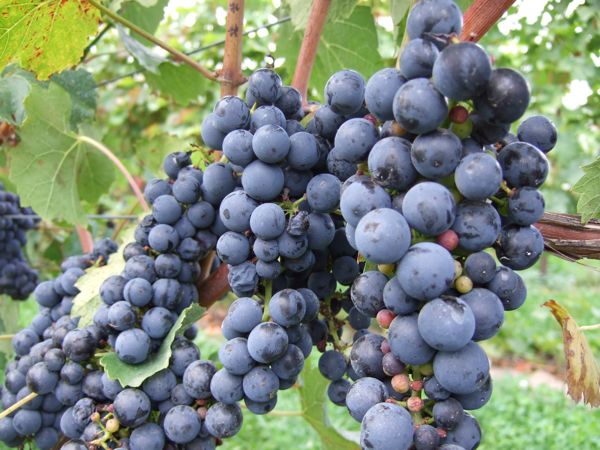
La Cabernet Franc da lugar a vinos más suaves que la Cabernet Sauvignon. Se cultiva para producir vinos tintos o rosado. Los vinos Cabernet Franc son más pobres en taninos que los Sauvignon y por eso suelen ensamblarse para obtener un caldo más sutil y complejo acelerando su crianza y evolución ..........(Lee Mas)
La Cabernet Franc es una de las cepas que dieron origen al cultivo del Cabernet Sauvignon. Los vinos Cabernet Franc tienen un profundo color púrpura cuando son jovenes y un aroma herbal.
Vista: El Cabernet Franc es un vino de color rojo rubí brillante.
Olfato: En nariz el Cabernet Franc es suave y delicado, presenta aroma herbáceo con notas a frutas rojas maduras como la frambuesa y en algunas ocasiones recuerda a mermelada.
Sabores: De alcohol moderado y sabor seco, ligero y de fina textura. Cuando no se abusa del roble, delicadamente tánico.
Maduración
Se creía que la capacidad de envejecimiento del Cabernet Franc era relativamente corta pero actualmente por experiencias realizadas se sabe que su capacidad de envejecer es, incluso, superior a la Cabernet Sauvignon.
Maridajes:
El Cabernet Franc es ideal para acompañar:
Carnes asadas;
Guisos con hierbas y frutas;
Carne de pato;
Quesos bien curados.
La temperatura a la cual se debe servir un Cabernet Franc, ronda entre los 17º a 18º, la cual le permite al vino exponerse delante de nosotros destacando sus aromas y sabores.
The Cabernet Franc gives rise to softer wines than the Cabernet Sauvignon. It is grown to produce red or rosé wines. Cabernet Franc wines are poorer in tannins than Sauvignon and that is why they are usually assembled to obtain a more subtle and complex broth accelerating their aging and evolution .......... (Read More)
Cabernet Franc is one of the strains that gave rise to the cultivation of Cabernet Sauvignon. Cabernet Franc wines have a deep purple color when they are young and have an herbal aroma.
View: Cabernet Franc is a bright ruby red wine.
Smell: On the nose, Cabernet Franc is soft and delicate, has a herbaceous aroma with notes of ripe red fruits such as raspberries and sometimes reminds of jam.
Flavors: Moderate alcohol and dry, light flavor and fine texture. When oak is not abused, delicately tannic.
Maturation
It was believed that the aging capacity of the Cabernet Franc was relatively short but nowadays, it is known from experience that its ability to age is even higher than the Cabernet Sauvignon.
Pairing:
The Cabernet Franc is ideal to accompany:
- Roasted meats;
- Stews with herbs and fruits;
- Duck meat;
- Well cured cheeses.
The temperature at which a Cabernet Franc should be served, ranges between 17º to 18º, which allows the wine to be exposed in front of us highlighting its aromas and flavors.
Merlot
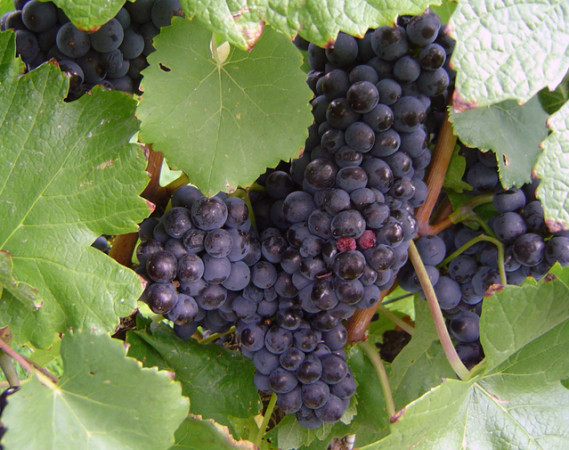
La Merlot es originaria del sudoeste de Francia es la segunda cepa tradicional y en importancia de los grandes vinos de Bordeaux. Los vinos de Merlot son vinos con cierta intensidad colorante, con grado alcohólico elevado y con ligeros aromas afrutados y especiados. ..........(Lee Mas)
El Merlot es parecido al Cabernet Sauvignon, pero es menos tánica; por lo que da vinos más livianos para beber, más jugosos y que maduran más pronto, que de algún modo parecen más dulces. El Merlot se puede considerar como una cepa tinta de calidad aceptable. A la Merlot siempre se la ha considerado como una uva complementaria para mezclarla con la Cabernet Sauvignon, se logra un bivarietal excelente ya que uno aporta suavidad y carnosidad y el otro estructura. En menor medida se mezcla con la Cabernet Franc. Hay dos teorías sobre el origen de la palabra que da nombre a esta variedad. Una viene del dialecto bordelés, en el que Merlot quiere decir “petit oiseau noir” (mirlo (pajarito negro)).
El Merlot es la primera uva de la temporada, ese momento en que los mirlos atacan las cepas para alimentarse. La otra teoría asocia el color del plumaje del mirlo con el azul negruzco de las bayas de la cepa.
Vista: A la vista el Merlot presenta un color rubí intenso con tintes violáceos y depende de la zona de elaboración. Los Merlot de guarda suelen ser más oscuros que los jóvenes.
Olfato: El Merlot tiene como aromas principales cassis, grosellas, moras u otros frutos rojos, pimiento dulce, humo, guinda, violeta además de trufas y el cuero.
Sabores: A la boca el Merlot es agradable cuando es joven ya que no presenta gran cantidad taninos, presenta sabores a ciruela, pasa de uva, miel y menta.
Maduración
El Merlot puede beberse joven, incluso recién elaborado, no precisan envejecimiento en botella, aunque su maduración puede mejorarlos y volverlos más complejos. Como varietal da un vino de evolución rápida, con aromas frescos y frutales y de cuerpo elegante; para consumirlo como vino tinto joven o como vino joven con un ligero paso de pocos meses por barrica de roble.
Maridajes:
El Merlot es ideal para acompañar:
Platos con legumbres, frutos secos;
Verduras asadas;
Carnes de caza (pato, vizcacha, conejo);
Pescado en salsa;
Estofados o guisos livianos;
Arroz;
Quesos semiduros;
Como postre, con membrillos.
La temperatura de servicio de un Merlot, la cual le permite al vino exponerse delante de nosotros destacando sus aromas y sabores, ronda entre los 16º a 18º.
La Merlot is originally from the southwest of France and is the second traditional and important strain of Bordeaux’s great wines. Merlot wines are wines with a certain coloring intensity, with a high alcohol content and with light fruity and spicy aromas. ..........(Reed More)
Merlot is similar to Cabernet Sauvignon, but it is less tannic; so it gives lighter wines to drink, more juicy and that ripen sooner, which somehow seem sweeter. Merlot can be considered as an ink strain of acceptable quality. Merlot has always been considered as a complementary grape to mix with Cabernet Sauvignon, an excellent bivarietal is achieved since one provides softness and fleshyness and the other structure. To a lesser extent it is mixed with Cabernet Franc. There are two theories about the origin of the word that gives name to this variety. One comes from the Bordeaux dialect, in which Merlot means “petit oiseau noir” (blackbird (little black bird)).
The Merlot is the first grape of the season, that moment when blackbirds attack the strains to feed. The other theory associates the blackbird’s plumage color with the blackish blue of the strain berries.
View: In view, Merlot has an intense ruby color with violet dyes and depends on the processing area. Guardian Merlot tend to be darker than young people.
Smell: Merlot has as main aromas cassis, currants, blackberries or other red fruits, sweet pepper, smoke, icing, violet as well as truffles and leather.
Flavors: In the mouth, Merlot is pleasant when it is young since it does not present a large amount of tannins, it presents flavors of plum, raisins, honey and mint.
Maturation
Merlot can be drunk young, even freshly made, they do not require aging in the bottle, although their maturation can improve them and make them more complex. As a varietal, it gives a wine of rapid evolution, with fresh and fruity aromas and an elegant body; to consume it as a young red wine or as a young wine with a slight step of a few months through oak barrels.
Pairing:
The Merlot is ideal to accompany:
-
- Dishes with legumes, nuts;
- Roasted vegetables;
- Game meat (duck, vizcacha, rabbit);
- Fish in souce;
- Stews or light stews;
- Rice;
- Semi-hard cheeses;
- For dessert, with quinces.
The service temperature of a Merlot, which allows the wine to be exposed in front of us, highlighting its aromas and flavors, is between 16º and 18º.
Cabernet Sauvignon
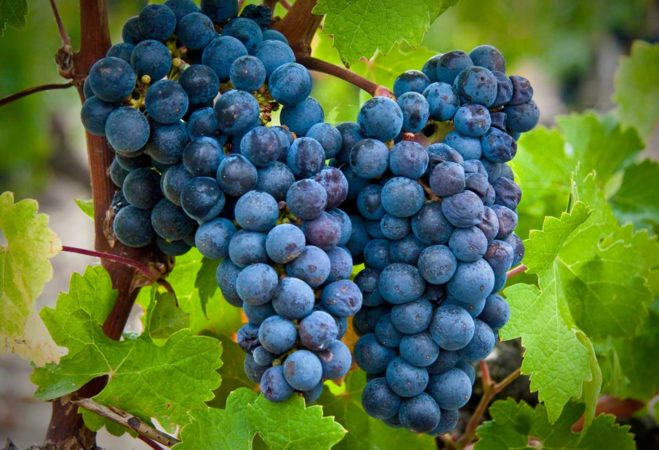
El Cabernet Sauvignon puede ser considerado como el equivalente en vino tinto al Chardonnay. Se trata de una uva de color intenso, bayas pequeñas y gruesos hollejos que produce vinos elegantes, ricos y sensuales. El Cabernet Sauvignon se caracteriza por sus taninos densos y aristocráticos, su color intenso, sus complejos aromas frutales y su estructura elegante. ..........(Lee Mas)
Es uno de los tintos con más potencial (a causa de los taninos que provienen de las pieles) de envejecer durante mucho tiempo, y ganan en categoría si envejecen en roble. Sus poderosos taninos y viva acidez proporcionan vinos duros en su juventud. Apreciada como “mejorante” en vinos de potencial oxidativo. El Cabernet Sauvignon se mezcla con otras variedades menos tánicas como Merlot o Cabernet Franc, mejora notablemente las características organolépticas.
Vista: El Cabernet Sauvignon a la vista se observa como un vino intenso, pesado, que ya ofrece muestras de su gran cuerpo. De colores muy intensos rojo oscuro, rubí, con notas violáceas que viran al ladrillo con el tiempo.
Olfato: Entre los aromas primarios que ofrece el Cabernet Sauvignon, se destaca la esencia de grosella, cerezas y ciruelas, tal vez aromas a tabaco o chocolate, si el cabernet sauvignon ha pasado por barrica. Cuando el nivel de maduración es bajo muestra el aromo típico de pimiento verde.
Sabores: El Cabernet Sauvignon en boca presenta sabores a pino, cedro, grafito, chocolate negro y aceitunas negras. A través del tiempo va sufriendo transformaciones que lo hacen de aroma profundo, aterciopelado, de muy buen paladar y estructura. Los Cabernet Sauvignon de jóvenes son ásperos y duros, por lo que agradecerán una crianza en roble o envejecimiento en botella para domar su consistente estructura.
Maduración
El Cabernet Sauvignon es un vino añejable por excelencia, el paso por roble nuevo aumenta su complejidad y concentración. Debido a la buena cantidad de taninos y gran acidez que posee en su juventud resulta bastante áspero y astringente en boca, lo cual beberlo joven no deja de ser toda una experiencia. Se suaviza cuando pasa un período en barricas de roble. Alcanza su plenitud después de mucho madurar en madera y añejarse en botella, conjugando los aromas de la madera con los frutados de la cepa. Con un tiempo prolongado de guarda se obtiene una notable fineza.
Maridajes:
El Cabernet Sauvignon es ideal para acompañar:
Carnes rojas;
Carnes de caza (ciervo, jabalí, conejo);
Cordero;
Guisos;
Comidas con salsas fuertes;
Carnes a la parrilla.
La temperatura de servicio de un Cabernet Sauvignon, la cual le permite al vino exponerse delante de nosotros destacando sus aromas y sabores, ronda entre los 16º a 18º, para un cabernet joven y entre los18º-20º, para un vino de guarda. Para un vino de guarda seria recomendamos usar decantador, aproximadamente una hora antes de
beberlo.
Cabernet Sauvignon can be considered as the equivalent in red wine to Chardonnay. It is a grape of intense color, small berries and thick skins that produces elegant, rich and sensual wines. Cabernet Sauvignon is characterized by its dense and aristocratic tannins, its intense color, its complex fruity aromas and its elegant structure. ..........(Reed More)
It is one of the reds with more potential (because of the tannins that come from the skins) to age for a long time, and win in category if they age in oak. Its powerful tannins and live acidity provide hard wines in its youth. Appreciated as “improver” in wines of oxidative potential. Cabernet Sauvignon is mixed with other less tannic varieties such as Merlot or Cabernet Franc, significantly improving organoleptic characteristics.
View: The Cabernet Sauvignon in sight is seen as an intense, heavy wine, which already offers samples of its great body. Very intense dark red, ruby, with violet notes that turn the brick over time.
Smell: Among the primary aromas offered by Cabernet Sauvignon, the essence of redcurrant, cherries and plums stands out, perhaps aromas of tobacco or chocolate, if the cabernet sauvignon has passed through the barrel. When the level of ripeness is low, it shows the typical green pepper aroma.
Flavors: The Cabernet Sauvignon in the mouth presents flavors of pine, cedar, graphite, dark chocolate and black olives. Through time it undergoes transformations that make it deep, velvety aroma, very good palate and structure. The Cabernet Sauvignon of young people are rough and hard, so they will appreciate an aging in oak or aging in the bottle to tame its consistent structure.
Maturation
The Cabernet Sauvignon is an aged wine par excellence, the passage through new oak increases its complexity and concentration. Due to the good amount of tannins and great acidity that he has in his youth it is quite rough and astringent in the mouth, which drinking it young is still an experience. It softens when a period passes in oak barrels. It reaches its fullness after long maturing in wood and aged in the bottle, combining the aromas of the wood with the fruity of the strain. With a prolonged time of guard, a remarkable fineness is obtained.
Pairing:
The Cabernet Sauvignon is ideal to accompany:
- Red meat;
- Game meat (deer, wild boar, rabbit);
- Lamb;
- Stews;
- Meals with strong sauces;
- Grilled meats.
The service temperature of a Cabernet Sauvignon, which allows the wine to be exposed in front of us, highlighting its aromas and flavors, ranges between 16º to 18º, for a young cabernet and between 18º-20º, for a wine of care. For a serious aging wine we recommend using decanter, approximately one hour before drink it.
